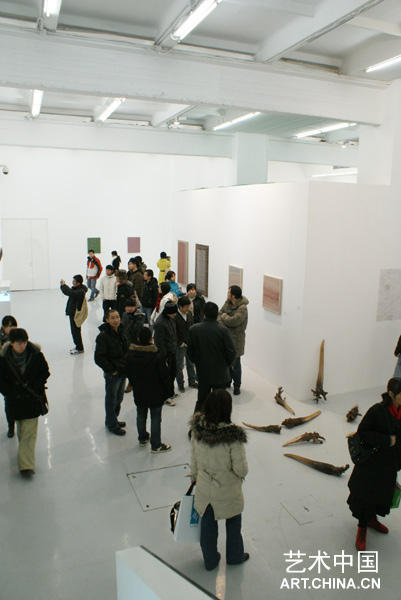
12月20日下午14:00,“物是:当代艺术中的物主题”展览在玛吉画廊开幕。
物是:当代艺术中的物主题
时间:2008-12-20—2009-2-8
地点:北京市朝阳区酒仙桥路4号798艺术区E06玛吉画廊
开幕酒会:2008-12-20 16:00
主办:玛吉画廊(北京)
策展人:鲍栋
项目负责:艾思
艺术家:邓猗夫、郭鸿蔚、蒋建军、金江波、金石、刘窗、杨心广、苏文祥、王光乐、王思顺
如果说,哲学源于惊异,那么最初的惊异实际上源自于一个问题“这是什么?”,“这”的更确切的含义指的是“这个东西”,即某物(物品、符号、身体……)。因此,可以说哲学源于——甚至根本上就是——“物是什么”这个问题,而对这个问题的回答也已经对“我是什么”的回答。
对物的思考几乎贯穿了整个哲学史,当然在不同的阶段,物有着不同的身份和定义,无法在此逐一详述。从整体上而言,从古典时期的本体论哲学一直到启蒙时期的主体性哲学,物都是被派生、被宰制的客体,一直处在某种从属结构中。这种情形一直到尼采之后的哲学中才有所改变,物逐渐获得了自身的决定性,伴随着对形而上学的拆解,人们开始意识到了身体、能指、无意识的在场,也逐渐打破了建立主体形而上学的企图。如果说哲学史的前半段一直是在建立一种主体的同一性哲学的话,那么后半段就是在借助于物的力量去质疑、批判、颠覆这种同一性哲学。
在艺术史中,也可以发现这样一种现象,即从现代主义以来,艺术史的历次变革与调整或多或少、或隐或显地与对物性的关注与投入有关,对这一现象的梳理足以形成一部艺术史专著。但是在这里,我们只能尝试性地在这一主题下讨论一部分中国艺术家及他们的作品,而之所以选择这些艺术家,是因为他们的作品可以引发以下几个与“物”相关的问题:物是什么,物如何出场,这种出场与艺术有什么关系,物与人、物与社会的关系是什么,这些问题都可以归纳到对物性(Thinghood)的抽象思考与具体呈现上。
Thinghood: Object-related Themes in Contemporary Art
Dates: December 20, 2008 - February 8, 2009
Venue: Magee Art Gallery, E06, 798 Art District, No.4 Jiuxianqiao Road, Chaoyang District, Beijing
Opening: 4pm, December 20, 2008
Presented by: Magee Art Gallery | Beijing
Curator: Bao Dong
Project Manager: Sun Aisi
Artists: Deng Yifu, Guo Hongwei, Jiang Jianjun, Jin Jiangbo, Jin Shi, Liu Chuang, Yang Xinguang, Su Wenxiang, Wang Guangle, Wang Sishun
If we say that philosophy was born of astonishment, then the earliest astonishment was born of the question, “what is this”. The meaning of “this” is more accurately described as “this thing”, i.e. things (objects, icons, bodies…). For this reason, we could say that philosophy is rooted in – essentially is – the question of “what this thing is”, and the answer to this question is also the answer to “what am I”.
Thinking on things has permeated the entire history of philosophy, though of course in different stages, things have had different identities and definitions, which for practical reasons we will not delve into here. Overall, from the ontological philosophy of the classical era to the subjective philosophy of the enlightenment, things have been derived and dominated objects, always a subordinate construct. This state of affairs did not change until after the philosophy of Nietzsche, when things began to gain their own decisiveness. With the disassembly of metaphysics, people gradually became aware of the presence of the body, signifiers and the unconscious, and eventually thwarted the schemes of subjective metaphysics. If we say that the first half the history of philosophy was about establishing a subjective unified philosophy, then the second half has been about using the power of things to cast doubt on, criticize and subvert this unified philosophy.
In art history we can also see such a phenomenon in that since modernism, all of the transformations in art history have more or less been about shifting the focus to thinghood; there is enough on this subject in art history to write an entire book. Here, however, we can only dabble a bit in using this theme to discuss certain Chinese artists and their works. The artists under discussion have been chosen because they can open up the following issues regarding “things”: what things are, how they appear, what relation their appearance has to art, and what the relationships are between things and man and things and society; all of these issues can fall under abstract thinking on thinghood and the specific presentation thereof.


|

